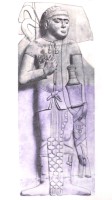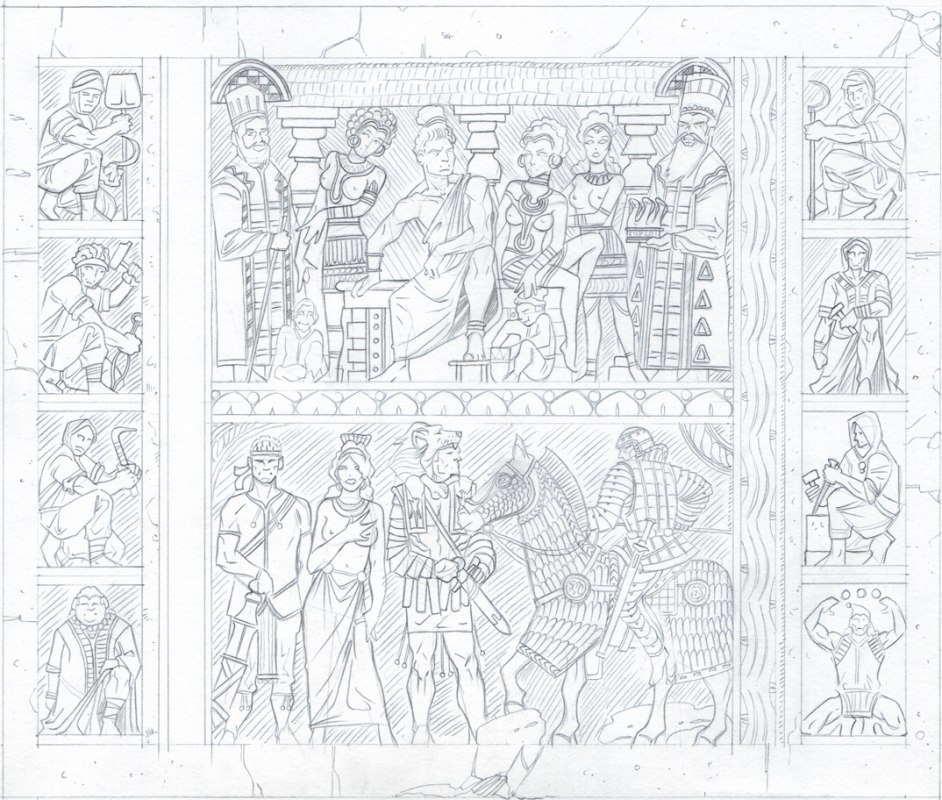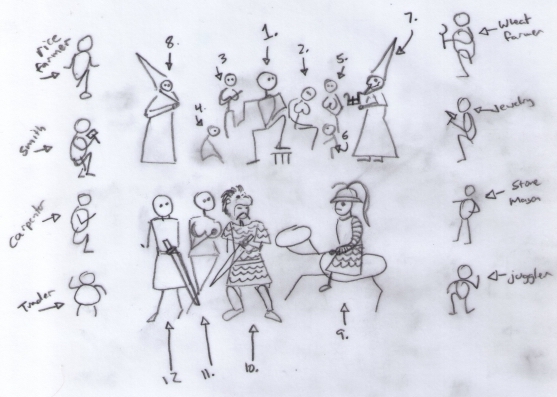Submitted by Jeff on Mon, 23/04/2012 – 00:27
The Guide to Glorantha will feature in-depth treatment of the Malkioni (along with the other major cultures of Glorantha). Here’s the art direction for one of the pictures in the Guide: the Crowning of King Bailifes:
This picture depicts a frieze that decorates a temple or palace wall in the far west. The art of these people is similar to Greco-Buddhist Art of around 200 BC in Bactria and India. These people are famed as philosophers and as magicians, and organize their society into four hereditary castes (like Hindu castes but even more severe): Workers, Soldiers, Priest, and Nobles.
Object: This is a relief carved into stone or ivory and decorates a temple or palace. The upper panel of the relief depicts the offering of the Serpent Crown to King Bailifes by the priestly caste. The lower panel of the relief depicts the military castes (Noble and Soldier) who support the king. The side panels depict the worker caste who enrich the kingdom.
Here’s my crude sketch:
Style: The style is Greco-Buddhist (a fascinating combination of Greek and Indian styles following Alexander’s conquests) of around 200 BC in Bactria and India. The picture itself is based on the following frieze from Gandhara:
The figures should be very detailed and realistic (as in the Greco-Buddhist style) – not like the very archaic and stylized figures in the Theyalan Procession (which is from a different culture), Here are more examples of Greco-Buddhist art work:
- http://upload.wikimedia.org/wikipedia/commons/3/30/PanchalaAndHariti.JPG (dead link)
- http://upload.wikimedia.org/wikipedia/commons/5/59/KushanMaitreya.JPG
- http://upload.wikimedia.org/wikipedia/commons/3/3c/BuddhistTriad.JPG
- http://upload.wikimedia.org/wikipedia/commons/0/00/MaraAssault.jpg
- http://upload.wikimedia.org/wikipedia/commons/f/fb/Paranirvana.JPG
These examples are just to give a feeling for the style. The attached image (Gandhara la grande rinuncia) is the actual reference image.
Figures:
Top Panel
1. King. The King wears a long skirt and jewelry. His hair is long, but curled up atop his hat. looks similar to this:
- Talar.jpg (broken link)
He seated upon his throne, confident and proud, and looking right at the High Priest (figure 7).
2. Royal Concubine. One of the king’s three dancing girl-wives, she is bare-breasted, wears jewelry, and is beautiful.Her attention is on the king. Based on Hindu apsaras:
- http://upload.wikimedia.org/wikipedia/commons/thumb/0/01/KarnatakaApsara.jpg/220px-KarnatakaApsara.jpg (dead link)
- http://commons.wikimedia.org/wiki/File:Apsara_441.jpg
- http://upload.wikimedia.org/wikipedia/commons/0/04/WLA_haa_Surasundari_India_Khajuraho_Madhya_Pradesh.jpg
3. Royal Concubine.One of the king’s three dancing girl-wives, she is bare-breasted, wears jewelry, and is beautiful. Similar to Fig 2.
4. Child. A small child plays at the king’s feet.
5. Royal Concubine.One of the king’s three dancing girl-wives, she is bare-breasted, wears jewelry, and is beautiful. Similar to Fig 2.
6. Child. Another small child plays at the king’s feet.
7. High Priest. This is the chief priest of the kingdom. He is an old man with a pointed beard, wears a tall hat and long-sleeved robes, similar to this:

His clothing is marked with the Law Rune:
The high priest is presenting the king the Serpent Crown, the sacred regalia of the kingdom.
The Serpent Crown is a “crown of serpents” – it might look like these:
- http://www.flickr.com/photos/k_dude/2831647260/
- http://www.marveldirectory.com/pictures/miscellaneous/serpantcrown1.gif (dead link)
- http://eden-saga.com/img/images/naga-kanya-femme-serpent-200po.jpg (dead link)
or whatever your artist thinks looks coolest.
8. Priest. This figure is dressed similarly to figure 7. He is looking at the king.
Lower Panel:
9. Noble Cavalryman. This cataphract wears a bronze breastplate, a skirt of scale armor, and his arms are covered in bronze plates. He rides a horse, which may also be armored. Examples:
- http://unitedcats.files.wordpress.com/2008/10/parthian_cataphract.gif
- http://greatestbattles.iblogger.org/Persia/parthian_cataphracts.jpg
- http://4.bp.blogspot.com/_je7KEKuAc1E/SQmecpSCrSI/AAAAAAAABLc/El1iqy4U_KE/s400/cataphract.jpg
- http://iranpoliticsclub.net/photos/U10-Parthian2/images/Arsacid%20Parthian%20Cataphract%20vs%20Saka%20&%20Kushan.jpg
10. Lion Soldier. This warrior wears scale armor and wears a lion-skin . Examples:
- http://mythologica.fr/grec/pic/heracles08.jpg
- http://www.flickr.com/photos/antiquitiesproject/4869987580/
Unlike Heracles, the Lion Soldier has a big mustache and no beard.
11. Aristocratic Woman. Similar to the royal concubines, this woman is barebreasted and wears jewelry.
12. Soldier. This warrior looks like this:

Left Side Panel:
This side panel depicts four members of the worker caste, each belonging to their respective guild. They carry tools associated with their occupation, and wear little more than a loin cloth and anything necessary for their trade.
- Rice Farmer. This worker carries a shovel and a short-bladed sickle.
- Smith. This worker has hammer and tongs.
- Trader. This worker is fat and wears jewelry.
- Carpenter. This worker has a bronze age style axe:
Right Side Panel:
This side panel depicts four members of the worker caste, each belonging to their respective guild. They carry tools associated with their occupation, and wear little more than a loin cloth and anything necessary for their trade.
- Wheat Farmer. This worker carries a long-bladed sickle.
- Jeweler. This worker hasa small hammer or other jewelry tools.
- Juggler. This entertainer is dancing and juggling balls.
- Stone Mason. This worker has stone working tools:
First Draft Sketch from the Artist:
Here’s the first draft sketch from the artist (who is absolutely wonderful):

A few minor details were corrected in this (the king’s clothing changed somewhat, mustaches added, feathers added to the helmet of the cataphract, and runes added to weapons and some garments), but this is pretty close to the final picture that will appear on the website.
Submitted by Rick on Wed, 25/04/2012 – 15:49.
The West, as originally envisioned by Greg, is very different from the vast majority of what has been written thus far. Greg’s West never had a Robin Hood-like figure operating out of the forests, nor Monks that could pose for a picture on a Belgian beer bottle, nor Cathedrals that look surprisingly similar to Notre Dame.
Submitted by Jeff on Wed, 25/04/2012 – 01:18.
This is likely from the 16th century or early in Guilmarn’s reign. I doubt official fashions have changed much, as the Rokari wizards are very much in favor of each caste sticking to its correct attire.
The Loskalmi idealize the depiction of the human form (ignoring the gross imperfections of the material world) and often depict their heroes completely in the nude. They have no caste costumes. Of course, most normal Loskalmi dress for the weather; although those who have risen to Men-of-All status (or higher) likely know spells that allow them to shrug off cold and other material, mundane discomforts. After all, did not Prince Snodal trek across the endless Valind Glacier to Altinela?
Editor-in-Chief, Moon Design Publications
Submitted by Daniel Adamov on Wed, 25/04/2012 – 00:17.
Joining the “this is Rokari?!” crowd, mostly because I originally assumed this was from an earlier period. I wonder if the fashions would have changed at all since then; but then, I suppose Rokari would if anything be very much in favour of sticking to traditional attire!
Presumably Loskalmi dress is a bit more… covering, though, especially considering the climate.
Be that as it may, the frieze is beautiful. I find I actually do like this art style for the West. The king in particular looks very… Classical.
Submitted by Herve on Tue, 24/04/2012 – 14:54.
No doubt Guilmarn aka “the fat” or “lardbutt” would love to look like the King depicted on this fresco ! Perhaps this King had zzaburi cast a spell of Glamour on him, or the artist aptly chose to make him look so. BTW, I recognize Bardas the sculptor, who included himself in this frieze !
Submitted by OrlanthiFool on Tue, 24/04/2012 – 13:13.
Jeff your stick-figure art has improved dramatically.
The “real” art is amazing.
Neil
Submitted by mikegibb on Mon, 23/04/2012 – 14:49.
I should also have added, that I think Jeff’s original is kinda cute too! The soldier on the bottom row looks like he is wearing a trollkin head over his helmet!!! 😉
Submitted by Herve on Mon, 23/04/2012 – 14:11.
Seshnela has officially gotten more… appealing. No more “dull and drab country” with this kind of attire for Ladies ! Seriously, this is beautiful artwork. And bravo for slipping the Serpent Crown from Marvel in there ! Always loved this evil relic.
Submitted by mikegibb on Mon, 23/04/2012 – 06:08.
This is wonderfully colourful and evocative – more so than I ever found previous visualisations of the West. Has, as I think I have said before, an almost RE Howard quality to it. They have a serpent crown FFS! That is just dying for some mighty thewed barbarian to come and rip it from the king’s head!
Submitted by Jeff on Mon, 23/04/2012 – 03:10.
The extremely talented studios of Alberto Foche. Here’s some of their links:
Editor-in-Chief, Moon Design Publications
Submitted by Eric Vanel on Mon, 23/04/2012 – 03:07.
This frieze is absolutely wonderful !!
Who is the artist working on it ?
Submitted by Jeff on Mon, 23/04/2012 – 01:21.
Or as described in the Guide:
“The Rokari sect of Malkionism (or as it calls itself, “The Right Way” or “Malkioni True Church”) dominates Seshnelan religious thought. Hierarchical and centralized, Rokarism is led by its Watcher Supreme. Rokari wizards believe upholding the ancient castes of Worker, Soldier, Wizard, and Noble is required by Malkion’s cosmic laws. They believe a man need only master his own duties of caste in life to achieve salvation, called “Solace”, and philosophically value a great farmer as much as a mighty warrior or powerful king. Converts to Rokarism are assigned to the most appropriate caste by the local ruler whose decision is final.”
Editor-in-Chief, Moon Design Publications
Submitted by Jeff on Mon, 23/04/2012 – 01:14.
Yes, this is a Rokari frieze. As I said, Greg and I have really been working on the West pretty intensely for the last five or six years. Rokarism cares about caste restrictions, caste taboos, and caste mingling, and does not try to restrict sex, beauty, sensuality – if it is caste appropriate. Bad for wizards, perfectly acceptable for Soldiers, mandatory for Nobles.
Editor-in-Chief, Moon Design Publications
Submitted by metcalph on Mon, 23/04/2012 – 01:09.
*Cough*, *Splutter*
This is a Rokari frieze?!?
I’m still getting my head around that but it’s still very impressive.


